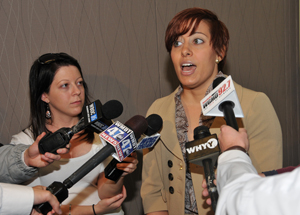DSU’s Optics Program Goes to Mars
|
|
 Ph.D candidate Alissa Mezzacappa (r) shares with the media how the experience has enhanced her life's work. Ph.D candidate Alissa Mezzacappa (r) shares with the media how the experience has enhanced her life's work. |
|
|
Article and photos by Carlos Holmes.
|
|
 Ph.D candidate Alissa Mezzacappa (r) shares with the media how the experience has enhanced her life's work. Ph.D candidate Alissa Mezzacappa (r) shares with the media how the experience has enhanced her life's work. |
|
|
Article and photos by Carlos Holmes.